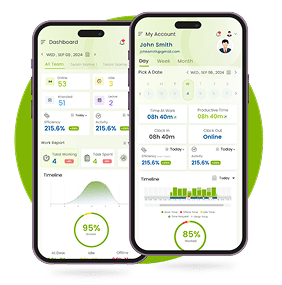Ever notice your team slows down after long hours of continuous work? You’re not imagining it: a 2025 study shows that 29% of full-time employees often skip their work breaks, and 16% experience frequent interruptions.
Ignoring breaks reduces cognitive performance, increases mistakes, and raises the risk of back pain, neck and shoulder strain, fatigue, and emotional exhaustion. Yet many organizations still equate longer hours with higher productivity, overlooking the fact that efficiency drops sharply when work stretches on without proper downtime.
In this blog, we will look into why structured breaks are essential for focus, wellness, and long-term productivity and how a time tracking software like Desklog with integrated wellness features can help keep your employees in their best health, mentally and physically.
We’ll cover:
The science behind timed breaks
How breaks improve productivity & focus
Practical break scheduling strategies
Desklog’s features to automate and track wellness-driven workflows
Tips for building a wellness-first company culture
Quick Answer Box:
Timed breaks improve productivity by giving your brain time to recharge, preventing fatigue and improving focus, creativity, and decision-making. Backed by cognitive science, short, structured breaks align with natural energy cycles, reduce stress and help sustain performance throughout the day. Tools like Desklog make it easy to schedule, track and optimize these wellness-driven breaks for lasting productivity.
Timed breaks improve productivity by giving your brain time to recharge, preventing fatigue and improving focus, creativity, and decision-making. Backed by cognitive science, short, structured breaks align with natural energy cycles, reduce stress and help sustain performance throughout the day. Tools like Desklog make it easy to schedule, track and optimize these wellness-driven breaks for lasting productivity.
The Science of Timed Breaks
Timed breaks are not a luxury; they are a science-backed approach to maintaining cognitive performance, creativity and long-term productivity.
Cognitive Recovery During Short Breaks
The human brain is not designed for continuous focus for hours. Attention Restoration Theory (ART) suggests that mental fatigue builds up over time and impairs problem-solving and creativity. Short breaks allow the brain to recover by giving the prefrontal cortex a pause from demanding tasks.
Pomodoro-style cycles (25–50 minutes of focused work followed by a 5–10-minute break) help employees sustain attention throughout the day. This approach prevents cognitive overload, allowing employees to tackle tasks with renewed energy and clarity.
Productivity Spikes After Structured Rest
Multiple studies show that regular breaks increase productivity by 10–20%. For instance, the widely cited “52/17 rule” suggests 52 minutes of focused work followed by a 17-minute break, which allows employees to maintain peak performance without burnout.
Breaks also improve decision-making quality. Employees who step away from mentally exhausting tasks are less likely to make impulsive errors, reducing costly mistakes and improving overall efficiency.
Burnout Prevention and Mental Health
Continuous work without breaks is a significant contributor to employee burnout, a growing concern for organizations worldwide.
Burnout leads to:
Increased turnover
Decreased engagement and creativity
Structured breaks act as preventive maintenance for mental health, helping employees manage stress, improve mood and maintain consistent output throughout the day. Organizations prioritizing breaks also see higher job satisfaction and stronger retention rates.
Why Most Workdays Fail at Wellness
Despite the clear benefits, most organizations struggle to integrate effective break strategies into daily workflows.
Long Hours vs. Efficiency
Working longer hours doesn’t necessarily mean getting more done. Research shows productivity sharply declines after 40–50 hours per week, and mistakes increase exponentially. Employees often remain logged in while mentally checked out, leading to wasted time and stress.
Remote & Hybrid Team Fatigue
Remote and hybrid work setups introduce unique challenges:
No natural office cues: Without colleagues moving around or scheduled meetings, employees may skip breaks entirely.
Blurred work-life boundaries: Employees working from home often extend their work hours, increasing fatigue.
Screen fatigue: Continuous video calls, chat notifications, and multitasking make breaks even more essential.
Managers’ Blind Spots in Employee Wellness
Many managers rely on manual tracking of hours or task completion. This often ignores downtime, leaving patterns of overwork undetected.
Without accurate insights into focus periods, idle time, and rest adherence, organizations risk burnout and declining productivity.
Key Metrics to Track Productivity Along with Well-Being
True productivity isn’t measured in hours; it’s measured in how we manage focus and rest.

Focus Time & Distraction Intervals
Maintaining deep focus is essential for quality output, yet mental fatigue and distractions can silently erode productivity.
Tracking focus time and distraction intervals helps identify when employees are most engaged and when their concentration starts to dip which is a signal that recovery time is needed to prevent burnout.
Break Adherence & Efficiency Correlation
When employees take regular, structured breaks, their energy levels and decision-making quality remain consistently high.
Tracking break adherence alongside productivity data shows how rest impacts performance, helping organizations prove that wellness directly fuels efficiency.
Employee Engagement & Mood Trends
Low engagement and persistent stress can signal declining well-being long before burnout sets in. Tracking engagement and mood trends helps managers intervene early, ensuring a supportive work environment that sustains motivation and morale.
Designing a Wellness-Driven Workday
Creating a wellness-driven workday involves strategically placing breaks while aligning with business needs.
Pomodoro & Micro-Break Scheduling
Short, frequent breaks are more effective than fewer long ones. Recommended intervals:
Focus period: 25–50 minutes
Break period: 5–15 minutes
Employees using these cycles report higher concentration, lower fatigue, and improved mood.
Integrating Walks, Stretches, or Hydration
Breaks don’t have to be digital. Effective wellness activities include:
Walking outdoors or inside the office
Stretching or desk yoga
Drinking water or having a healthy snack
These activities recharge both mind and body, improving subsequent focus and alertness.
Aligning Break Schedules with Project Demands
Breaks should complement team workflows:
Avoid interrupting collaborative sessions
Schedule group breaks for social bonding
Adjust timing according to deadlines or high-focus periods
This ensures breaks improve productivity instead of disrupting it.
Desklog Features That Support Timed Breaks
Desklog’s employee wellness feature makes it simple to implement and measure effective break strategies.
Automated Break Reminders & Focus Tracking
Enabling the wellness module helps employees receive gentle reminders to step away after predetermined focus intervals.
How Desklog supports wellness:
Short micro-breaks (hydration, stretching, eye relaxation) and longer resets (deep breathing, snack & sip, leaning back) are triggered to restore energy during the day.
The Wellness Module is fully configurable. Admins can customize break-intervals, enforce strict or flexible modes, trigger activities during deep work only, and set idle-time thresholds.
Making Breaks Work Without Losing Momentum
Taking regular breaks doesn’t have to slow down productivity. By finding the right balance between flexibility and structure, workplaces can help employees recharge while keeping momentum.
Encouraging a wellness-first culture ensures breaks become a natural part of the workday rather than an afterthought.
Scheduling vs. Autonomy Balance
Wellness-driven workplaces strike a balance between:
Flexible breaks: Employees choose timing that works best for their workflow.
Structured breaks: Guidelines ensure breaks aren’t skipped and maintain overall productivity.
Encouraging a Wellness-First Culture
Managers can:
Model taking breaks themselves
Recognize employees who follow healthy work patterns
Conclusion
Structured breaks aren’t just a wellness perk; they promote productivity and long-term success. When employees are given intentional time to recharge, they return to their tasks with renewed focus, sharper decision-making and improved creativity, leading to higher-quality work and more efficient outcomes.
Beyond cognitive benefits, regular breaks help prevent burnout, reduce stress, and support overall mental and physical well-being, creating a healthier, more engaged workforce.
FAQ
1How do timed breaks improve productivity?
Timed breaks restore focus, reduce mental fatigue, and help employees work with renewed energy. They also improve creativity, improve decision-making, reduce errors, and support consistent high-quality performance throughout the day.
2How long should a break be for maximum efficiency?
Short breaks of 5–15 minutes after 25–50 minutes of focused work are most effective. They refresh the mind without interrupting workflow. Longer breaks can be used for meals, exercise, or social connection.
3Can Desklog automate reminders for breaks?
Yes. Desklog sends automated reminders for short micro-breaks or longer rest periods based on configurable schedules, ensuring breaks are taken consistently and promoting a culture of wellness without manual tracking.
4Does taking breaks prevent burnout?
Absolutely. Regular breaks reduce stress, prevent mental and physical exhaustion, and help maintain energy, engagement, and motivation over the long term, lowering absenteeism and turnover.
5How do breaks affect focus and attention span?
Breaks prevent cognitive overload, allowing employees to sustain deep focus and maintain high-quality work. They refresh the brain, extending attention span and reducing mental fatigue.
6Can remote teams benefit from scheduled breaks?
Yes. Scheduled breaks prevent screen fatigue, combat blurred work-life boundaries, and maintain engagement in remote and hybrid environments, ensuring employees recharge even outside traditional office settings.
7How can work demands be balanced with wellness breaks?
Align breaks with team workflows and project schedules, allow flexible timing when needed, and track productivity trends. Group breaks can also encourage collaboration and social interaction without affecting output.
8Can break tracking increase overall output?
Yes. Teams that follow structured breaks consistently show higher productivity, fewer errors, and better decision-making. Tracking both focus and rest proves that strategic downtime enhances efficiency and sustainable performance.

















